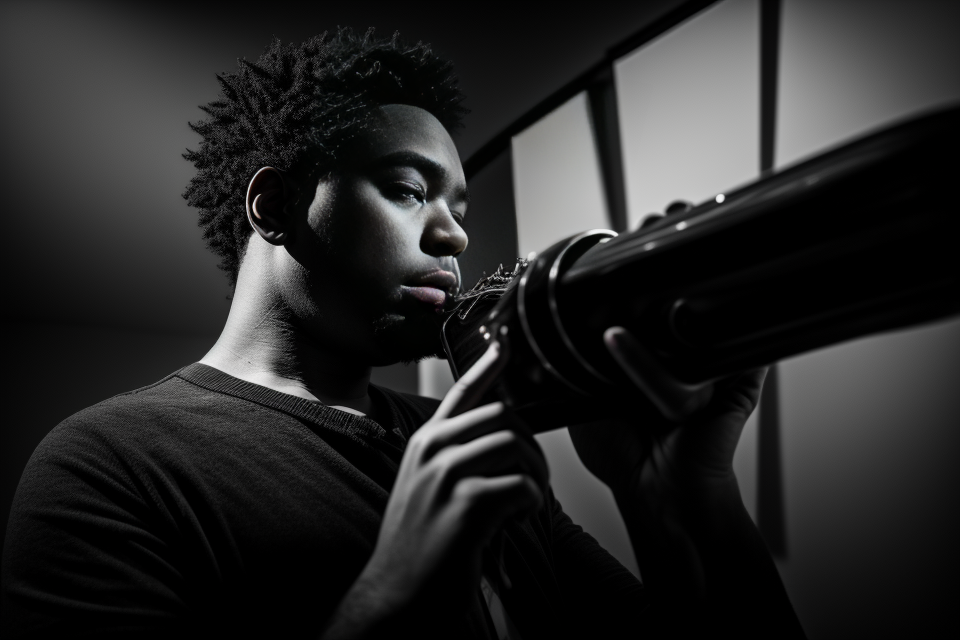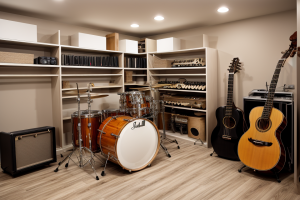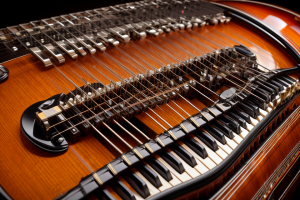
When it comes to music, the instrument you play can make all the difference in the world. Whether you’re a beginner or a seasoned pro, having the right instrument can help you to express yourself and bring your music to life. But when is the right time to invest in a new instrument? Should you wait until your current one breaks down, or should you upgrade as soon as possible? In this article, we’ll explore the signs that it’s time to buy a new instrument, and what to consider when making your decision. So whether you’re a guitarist, pianist, or any other kind of musician, read on to find out when it’s time to upgrade your instrument and take your music to the next level.
The right time to invest in a new instrument depends on several factors, including your musical goals, current financial situation, and the availability of the instrument. If you are a beginner, it may be more practical to rent an instrument initially to determine if you are committed to pursuing music before making a significant investment. However, if you are an experienced musician or have a specific project or performance in mind, it may be worth considering purchasing a new instrument. It is also important to consider the maintenance and upkeep of the instrument, as well as any potential resale value. Ultimately, the right time to invest in a new instrument is when it aligns with your musical needs and financial situation.
Factors to Consider Before Purchasing a New Instrument
1. Your Skill Level
a. Upgrading to a Professional-Grade Instrument
When it comes to upgrading to a professional-grade instrument, there are several things to consider. Firstly, you should evaluate your current skill level and determine whether you are ready to handle a more advanced instrument. Professional-grade instruments are designed for experienced players who have honed their skills and are looking to take their playing to the next level. If you are a beginner or intermediate player, it may be more beneficial to start with a lower-priced instrument and gradually work your way up as your skills improve.
b. Acquiring an Instrument Suitable for Your Skill Level
On the other hand, if you are a beginner or intermediate player, it is important to acquire an instrument that is suitable for your skill level. Playing an instrument that is too advanced for your current skill level can be frustrating and may hinder your progress. It is important to choose an instrument that is easy to play and has a good tone, so that you can focus on developing your skills without being discouraged by a poor-sounding instrument. Additionally, consider consulting with a music teacher or professional musician to help you determine the best instrument for your current skill level.
2. Your Financial Situation
a. Budgeting for an Instrument
When considering investing in a new instrument, it is essential to assess your financial situation and determine if you can afford it. Creating a budget is a crucial step in this process. Start by estimating the cost of the instrument, including any additional expenses such as maintenance, accessories, and lessons.
It is important to be realistic when budgeting for an instrument. Be sure to factor in unexpected costs that may arise, such as repairs or replacement parts. Additionally, consider the cost of the instrument over time, including potential increases in value or decreases in value due to wear and tear.
b. Making the Most of Your Budget
Once you have established a budget, it is important to make the most of your resources. Consider purchasing a used instrument as a more cost-effective option. Used instruments can be a great way to save money while still getting a high-quality instrument. Be sure to inspect the instrument thoroughly before making a purchase to ensure it is in good condition.
Another way to make the most of your budget is to shop around for the best deals. Research different vendors and compare prices to find the best value for your money. Additionally, consider purchasing an instrument that is within your budget but slightly below your desired price range. This can allow you to have more money available for accessories or lessons.
In conclusion, budgeting for an instrument is a crucial step in determining when the right time is to invest in a new instrument. By creating a realistic budget and making the most of your resources, you can ensure that you are making a wise investment that will provide you with years of enjoyment.
3. Your Musical Goals
a. Reaching New Musical Heights
- Expanding your musical skills and knowledge
- Pushing boundaries and challenging yourself
- Exploring new genres and styles
b. Enhancing Your Musical Experience
- Improving the quality of your sound
- Increasing your efficiency and speed
- Customizing your instrument to your personal preferences
When it comes to investing in a new instrument, your musical goals play a crucial role in determining the right time to make the purchase. Whether you’re looking to reach new musical heights or enhance your overall experience, understanding your objectives can help guide your decision-making process.
Reaching New Musical Heights
One of the main reasons to consider investing in a new instrument is to expand your musical skills and knowledge. By upgrading to a more advanced instrument, you can push your boundaries and challenge yourself to improve your craft. This may involve exploring new genres and styles, or refining your technique in your current genre of choice.
Additionally, a higher-quality instrument can provide you with a more diverse range of sounds and tones, allowing you to express yourself more fully in your music. With the ability to produce a wider variety of sounds, you can experiment with different textures and effects, giving your music a unique and distinctive edge.
Enhancing Your Musical Experience
Another factor to consider when deciding whether to invest in a new instrument is the potential to enhance your overall musical experience. By upgrading to a higher-quality instrument, you can improve the quality of your sound, making your music more enjoyable to listen to. Additionally, a better instrument can increase your efficiency and speed, allowing you to perform and record more quickly and accurately.
Customizing your instrument to your personal preferences can also enhance your musical experience. Different instruments offer various features and customization options, such as different types of pickups or customizable controls. By choosing an instrument that caters to your specific needs and preferences, you can create a more personalized and enjoyable playing experience.
In conclusion, your musical goals play a crucial role in determining the right time to invest in a new instrument. Whether you’re looking to reach new musical heights or enhance your overall experience, understanding your objectives can help guide your decision-making process.
Assessing the Condition of Your Current Instrument
1. Determining the Age and Condition of Your Instrument
a. Signs of Wear and Tear
Before deciding to invest in a new instrument, it is crucial to assess the condition of your current instrument. The first step in determining whether it’s time for an upgrade is to identify the age and condition of your instrument. Here are some signs of wear and tear that may indicate the need for a new instrument:
- Rusting or corrosion on the surface of the instrument
- Cracks or chips in the wood or other materials
- Dents or dings in the body of the instrument
- Loose or broken keys
- A noticeable change in the sound quality or tuning stability
b. Assessing the Longevity of Your Instrument
In addition to checking for signs of wear and tear, it’s also important to assess the longevity of your instrument. Instruments, like any other tools, have a lifespan, and it’s essential to consider whether your instrument has reached the end of its useful life. Some factors to consider when assessing the longevity of your instrument include:
- The quality of the materials used to make the instrument
- The level of maintenance and care the instrument has received over time
- The frequency and severity of repairs needed to keep the instrument in good condition
- The overall performance and sound quality of the instrument
By carefully evaluating the age and condition of your current instrument, you can determine whether it’s time to invest in a new one or if a repair or restoration will suffice.
2. Identifying Necessary Repairs
When it comes to determining whether or not it’s time to invest in a new instrument, it’s important to assess the condition of your current instrument. This involves identifying any necessary repairs that may be required to ensure that it continues to function properly.
a. Determining the Scope of Repairs
The first step in identifying necessary repairs is to determine the scope of the work that needs to be done. This involves taking a close look at the instrument and evaluating its overall condition. Depending on the extent of the damage or wear and tear, you may need to repair or replace certain components of the instrument.
For example, if the instrument has been exposed to extreme temperatures or humidity, the wood or metal components may have warped or corroded. In this case, you may need to have these components repaired or replaced to ensure that the instrument remains in good working order.
b. Evaluating the Cost-Effectiveness of Repairs
Once you have determined the scope of the necessary repairs, the next step is to evaluate the cost-effectiveness of these repairs. This involves considering the cost of the repairs versus the value of the instrument.
In some cases, the cost of repairs may be minimal and well worth the investment to keep the instrument in good condition. However, in other cases, the cost of repairs may be prohibitively expensive, and it may be more cost-effective to invest in a new instrument instead.
It’s important to weigh the cost of repairs against the value of the instrument and consider how long you plan to continue using it. If the instrument is of high value and you plan to use it for many years to come, it may be worth investing in repairs to keep it in good condition. However, if the instrument is of lower value or you don’t plan to use it for much longer, it may be more cost-effective to invest in a new instrument instead.
3. Deciding on a Repair or Replacement
When it comes to deciding whether to repair or replace your instrument, there are several factors to consider. Here are some things to keep in mind when making this decision:
a. The Pros and Cons of Repairing Your Instrument
Repairing your instrument can be a cost-effective way to extend its life and keep it in good condition. However, there are also some downsides to consider. Here are some pros and cons of repairing your instrument:
Pros:
- Repairs can be less expensive than buying a new instrument.
- Repairs can often be done quickly, so you won’t be without your instrument for long.
- Repairs can restore your instrument to its original condition, so you can continue to use it as you always have.
Cons:
- Repairs may not fix the problem entirely, and your instrument may still need to be replaced eventually.
- Repairs can change the sound or feel of your instrument, which may not be desirable.
- If the repair is not done properly, it could compromise the integrity of your instrument.
b. Making the Decision to Replace Your Instrument
If your instrument is in need of major repairs or if it is no longer meeting your needs, it may be time to consider replacing it. Here are some things to consider when making this decision:
- A new instrument can come with a warranty, which can provide peace of mind and protect your investment.
- A new instrument can be tailored to your specific needs and preferences, so you can be sure that it will meet your requirements.
-
A new instrument can often come with upgrades and improvements that are not available on older models.
-
A new instrument can be expensive, and it may be a significant investment.
- You may need to adjust to a new instrument, which can take some time and effort.
- You may have an emotional attachment to your current instrument, which can make it difficult to let go.
Overall, the decision to repair or replace your instrument will depend on a variety of factors, including the condition of your current instrument, your budget, and your personal preferences. By carefully considering these factors, you can make an informed decision that will ensure that you have the best possible instrument to meet your needs.
Making the Purchase
1. Researching Instrument Brands and Models
a. Assessing Quality and Performance
When it comes to researching instrument brands and models, assessing quality and performance is crucial. One way to do this is by reading reviews from experts and professionals in the field. These reviews can provide valuable insights into the instrument’s construction, sound quality, and overall performance. It is also important to consider the materials used in the instrument’s construction, as well as the manufacturer’s reputation for producing high-quality instruments.
b. Comparing Prices and Features
Comparing prices and features is another important aspect of researching instrument brands and models. While it is important to consider the instrument’s price, it is also important to remember that a higher price does not always mean a better instrument. Instead, it is important to compare the instrument’s features to other similar instruments in its price range. This can help to ensure that the instrument being purchased is a good value for its price. Additionally, it is important to consider any additional costs associated with the instrument, such as maintenance and repair costs, when making a purchasing decision.
2. Consulting with Musicians and Professionals
Consulting with musicians and professionals is an essential step when considering investing in a new instrument. They have the experience and knowledge to guide you through the process, ensuring that you make the right decision for your needs.
a. Gathering Opinions and Recommendations
One of the most valuable resources when purchasing a new instrument is the opinions and recommendations of other musicians. They can provide insights into the best instruments for your specific genre or style of music, as well as their personal experiences with different brands and models. Additionally, they can recommend the best places to purchase an instrument, such as local music stores or online retailers.
b. Utilizing the Expertise of Professionals
Another crucial aspect of consulting with musicians and professionals is utilizing their expertise. These individuals have spent years studying and playing their instruments, and they can provide valuable advice on selecting the right instrument for your needs. They can also offer guidance on proper maintenance and care, as well as provide tips on how to improve your playing skills.
Moreover, professionals can also help you to understand the difference between different grades of instruments, and guide you on what to look for when purchasing a new instrument. They can also provide information on the latest technology and innovations in instrument design, which can help you to make an informed decision.
Overall, consulting with musicians and professionals is an essential step when investing in a new instrument. They can provide valuable insights and advice, helping you to make the right decision for your needs.
3. Deciding on a New Instrument
a. Choosing the Right Instrument for You
When it comes to choosing the right instrument for you, there are several factors to consider. First and foremost, you should consider your musical goals and the type of music you want to play. Different instruments are better suited for different genres and styles of music. For example, if you want to play classical music, a violin or cello may be the best choice. If you want to play rock or pop music, a guitar or drum set may be more appropriate.
Another important factor to consider is your personal preferences and physical limitations. Some instruments may be more comfortable or easier to play for certain individuals, depending on their body size, hand size, and dexterity. It’s important to choose an instrument that feels comfortable and natural to play, as this will make it easier for you to learn and improve your skills.
Additionally, you should consider the cost and availability of the instrument. Some instruments, such as violins and cellos, can be quite expensive, especially if you’re purchasing a high-quality instrument. You may also need to consider the cost of lessons, accessories, and maintenance when budgeting for your new instrument.
b. Finalizing Your Decision
Once you’ve considered all of these factors, it’s time to finalize your decision. Take some time to research different brands and models, read reviews, and even try out instruments at a music store or rental facility. This will help you make an informed decision and ensure that you’re choosing the right instrument for you.
It’s also important to remember that you don’t have to commit to one instrument forever. Many musicians start out on one instrument and later switch to another, either because they discover a new passion or because they outgrow their initial instrument. Don’t be afraid to experiment and try new things – you may discover a new love for a different instrument down the road.
4. Purchasing and Maintaining Your New Instrument
a. Making the Purchase
When it comes to purchasing a new instrument, there are several factors to consider. First and foremost, it is important to set a budget for yourself and determine how much you are willing to spend. It is also important to do your research and compare prices from different vendors to ensure that you are getting the best deal possible.
Once you have found a reputable vendor and have set a budget, it is time to choose the instrument that is right for you. This may involve trying out several different instruments to determine which one feels and sounds the best. It is also important to consider the maintenance and repair costs associated with the instrument, as well as any additional accessories or equipment that may be necessary.
b. Ensuring Proper Maintenance and Care
Once you have purchased your new instrument, it is important to ensure that it is properly maintained and cared for. This may involve regular tuning, cleaning, and maintenance tasks, as well as keeping the instrument in a safe and secure location when not in use.
It is also important to consider the type of case or protective cover that you will use for your instrument, as this can help to protect it from damage and keep it in good condition over time. Additionally, you may want to invest in accessories such as strings, reeds, or other supplies that are specific to your instrument.
Overall, investing in a new instrument is a significant decision that requires careful consideration and planning. By setting a budget, doing your research, and ensuring proper maintenance and care, you can help to ensure that your new instrument will provide you with many years of enjoyment and musical growth.
FAQs
1. How do I know if it’s time to buy a new instrument?
Answer:
It’s important to consider several factors when deciding whether to invest in a new instrument. Some of these factors include the condition of your current instrument, your level of skill and proficiency, and your future goals as a musician. If your current instrument is in poor condition, has significant wear and tear, or is no longer able to produce the sound you desire, it may be time to consider purchasing a new one. Additionally, if you find that your current instrument is limiting your ability to progress as a musician, a new instrument may be necessary to help you achieve your goals.
2. What are the benefits of investing in a new instrument?
Investing in a new instrument can provide a number of benefits for musicians of all skill levels. A new instrument can offer improved sound quality, better tuning stability, and increased durability, allowing you to practice and perform at your best. Additionally, a new instrument can help you to achieve a more personalized sound and style, enabling you to express yourself more fully through your music. For more advanced musicians, a new instrument can also provide greater versatility and control over their sound, enabling them to push the boundaries of their playing and creativity.
3. How often should I expect to replace my instrument?
The frequency with which you will need to replace your instrument will depend on a number of factors, including the quality of the instrument, your level of skill and proficiency, and how often you play. As a general rule, lower-end instruments may need to be replaced more frequently than higher-end instruments due to wear and tear. For serious musicians, it’s important to regularly maintain and care for your instrument to extend its lifespan and ensure that it continues to provide the best possible sound and performance. However, in some cases, even with regular maintenance, it may still be necessary to replace your instrument after several years of use.







